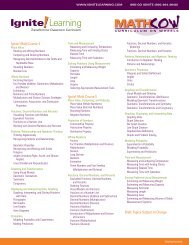The Silent Epidemic: Perspectives of High School ... - Ignite! Learning
The Silent Epidemic: Perspectives of High School ... - Ignite! Learning
The Silent Epidemic: Perspectives of High School ... - Ignite! Learning
Create successful ePaper yourself
Turn your PDF publications into a flip-book with our unique Google optimized e-Paper software.
Forward: Early Foundations <strong>of</strong> <strong>High</strong> <strong>School</strong> Dropout. Sociology <strong>of</strong> Education Vol. 70, Issue 2: 98; Garnier et al. (1997).<br />
<strong>The</strong> Process <strong>of</strong> Dropping Out <strong>of</strong> <strong>High</strong> <strong>School</strong>. American Educational Research Journal Vol. 34, Issue 2: 395-419;<br />
Roderick (1993). <strong>The</strong> Path to Dropping Out. Westport, CT: Auburn House; Ensminger & Slusacick (1992). Paths to <strong>High</strong><br />
<strong>School</strong> Graduation or Dropout: A Longitudinal Study <strong>of</strong> a First Grade Cohort. Sociology <strong>of</strong> Education 65: 95-113; Morris<br />
et al. (1991). Building a Model to Predict Which Fourth through Eighth Graders Will Drop Out <strong>of</strong> <strong>High</strong> <strong>School</strong>. Journal <strong>of</strong><br />
Experimental Education 59: 286-293; Barrington & Hendricks (2001). Differentiating Characteristics <strong>of</strong> <strong>High</strong> <strong>School</strong><br />
Graduates, Dropouts, and Nongraduates. Wisconsin: University <strong>of</strong> Wisconsin Center at Wausau, 309-318; Cairns et al.<br />
(1989). Early <strong>School</strong> Dropout: Configurations and Determinants. Child Development 60: 1437-1452.<br />
27 Alexander et al, 87-107.<br />
28 Rumberger (2001), 8.<br />
29 Barton, 13.<br />
30 This slow process <strong>of</strong> disengagement from school discussed in this paragraph is also reflected in our survey data<br />
focusing on class attendance. In 9th grade, 64 percent <strong>of</strong> our former students attended class more <strong>of</strong>ten than not; by<br />
10th grade this number falls to 51 percent; by 11th it is only at 42 percent; and by 12th grade, only 36 percent <strong>of</strong> our<br />
respondents attended their classes always or usually.<br />
31 Green, Leonard; Astrid F. Fry & Joel Myerson (1994). Discounting <strong>of</strong> Delayed Rewards: A Life-span Comparison.<br />
Psychological Science, v5 n1: 33.<br />
32 Barton, 25.<br />
33 Rumberger, Russell W. (1995). Dropping Out <strong>of</strong> Middle <strong>School</strong>: A Multilevel Analysis <strong>of</strong> Students and <strong>School</strong>s.<br />
American Educational Journal 32: 583-625.<br />
34 Rumberger (2001), 15; see also Valerie E. Lee and Julia B. Smith (1997). Restructuring <strong>High</strong> <strong>School</strong>s for Equity and<br />
Excellence: What Works, which analyzes federal data relating to almost 10,000 students in more than 750 public and<br />
private high schools <strong>of</strong> different sizes, and concludes that size affects such things as a sense <strong>of</strong> community within<br />
the school (negatively if the school is too big) and the ability to <strong>of</strong>fer a solid curriculum (negatively if the school is<br />
too small).<br />
35 Kerr, Kerri A. & Nettie E. Legters (2004). Preventing Dropout: Use and Impact <strong>of</strong> Organizational Reforms Designed to<br />
Ease the Transition to <strong>High</strong> <strong>School</strong> in Dropouts in America. Edited by Gary Orfield. Cambridge, MA: Harvard Education<br />
Press, 238.<br />
36 Dynarski, Mark (2004). Interpreting the Evidence from Recent Federal Evaluations <strong>of</strong> Dropout – Prevention Programs:<br />
<strong>The</strong> State <strong>of</strong> Scientific Research in Dropouts in America. Edited by Gary Orfield. Cambridge, MA: Harvard Education<br />
Press, 255-267.<br />
37 Rumberger, Russell W. & S.L. Thomas (2000). <strong>The</strong> Distribution <strong>of</strong> Dropout and Turnover Rates among Urban and<br />
Suburban <strong>High</strong> <strong>School</strong>s. Sociology <strong>of</strong> Education 73: 55-56.<br />
38 Rumberger (1995), 583-625; Rumberger et al. (1990). Family Influences on Dropout Behavior in One California <strong>High</strong><br />
<strong>School</strong>. Sociology <strong>of</strong> Education 63: 283-299; Astone & McLanahan (1991). Family Structure, Parental Practices and<br />
<strong>High</strong> <strong>School</strong> Completion. American Sociological Review Volume 56, Number 3: 309-320.<br />
39 Greene & Winters (2005), 1.<br />
Notes<br />
40 Rumberger (2001), 26-28, in which Rumberger identifies common features <strong>of</strong> effective programs, such as a<br />
non-threatening environment for learning, a caring, committed staff who accepted personal responsibility for student<br />
27








